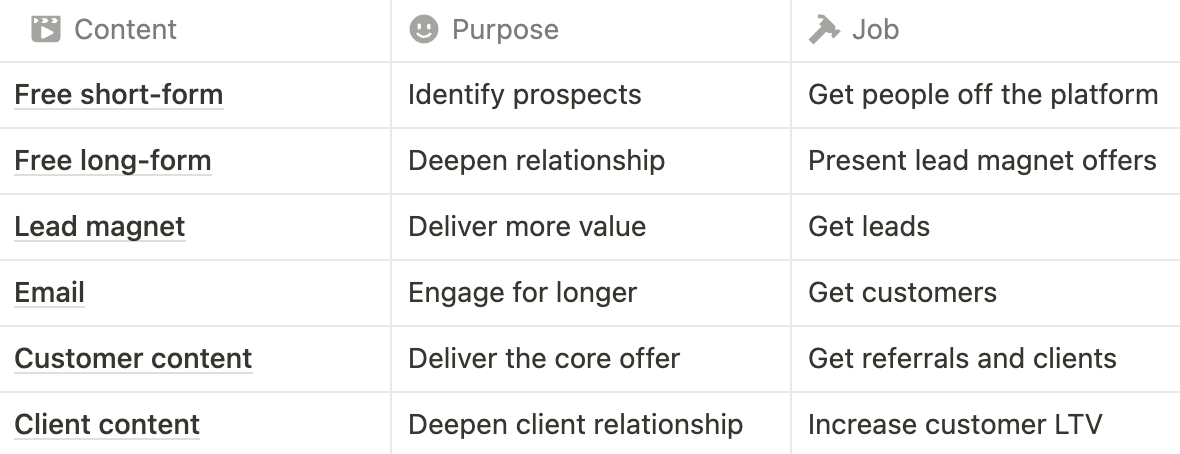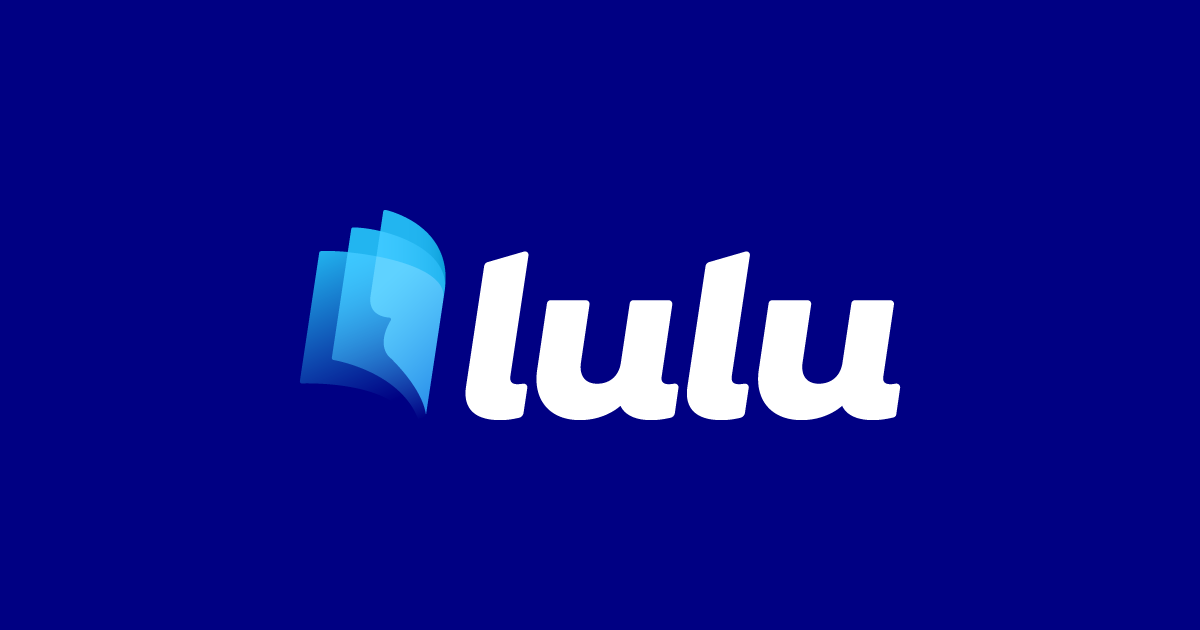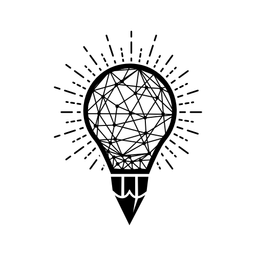The Craftsman Content Framework

We’ve made it! I hope you’ve done the work in the previous chapters to understand your offer as well as the principles that precede this content framework.
I’m making the broad assumption that you’ll use content as your main source of marketing. There are other forms, obviously, but there are plenty more qualified people to teach that stuff, and I’m happy to point you in their direction. A great place to start is Alex Hormozi’s $100m Leads. In it he outlines that there are only 4 Core ways in two categories for an individual to market to an audience:
1-1 MARKETING
- warm outreach
- cold outreach
1-MANY MARKETING
- content
- ads
As 90% or more of the creative entrepreneurs and business owners I know focus on content, we’ll start there. Alex’s book is a great resource for learning how to implement the other three. I recommend you focus on one from each category - direct or broad outreach - until it generates the outcomes that you want for your business, then expand to the other four. But you can also go full bore and get all four systems up and running. That’s what I’m doing leading up to the event I’m running in a few months, but that requires much more time, effort, and money than many creators have.
The goal of this framework is to create a frictionless path - similar to the Costco method - to pull your right-fit clients out of an audience of people every single day.
The first thing to understand about the framework is that we give every single piece of content a purpose and a job. They are different - one is a reason that it exists, and the other is the outcome that we’re tracking for that step so we know if that part of the system is working.
This framework will require you to put on a different hat at times, like I talked about in my last book. Every business needs an artist to create the work or deliver the services, a manager to build and optimize systems, and an entrepreneur to create the vision and drive the company. If you’re a company of one, surprise! You get to be all three. And if you’re an artist but don’t ever step into the manager or entrepreneur role, your business will suffer. The same goes for the other two if that’s your natural state.
Alright, enough preamble. Here’s what the framework looks like, then we’ll dive into each section and start building out the different parts of your business.
The Framework
Free short-form content > free long-form content > lead magnet > email > customer > client
At each step in the process, you have content that is pulling your right-fit client through every step. You can think of them as stepping stones - too far apart and your audience drops off. These steps become the path that every person travels to become a client of your business.
As we go through each step, we’ll identify the purpose and the job so that you can start building a tracking system that we’ll set up in the next section.
Free Short-Form Content
Your free short-form content is the audio, video, images, and text that you put out into the world on social media platforms. You’re strategically utilizing the algorithms on these platforms to get reach and to identify your right-fit clients from a massive audience of people.
This is your Costco sample cart. You put out short-form video, audio, images, or text and make it clear who it’s for and you see who comes to sample your offer.
If you’re a filmmaker, post behind-the-scenes photos from set, snippets of a finished project for a client, case studies, and testimonials, and share your thoughts on the process of creating the work you create.
If you’re a musician, share clips from a show, images from the studio, or of your music notebook, share lyrics or demos of your un-produced songs, and show fans smiling and singing along to your music.
The goal of your free short-form content is to give people a taste of what it’s like to engage with you and your business. How does it feel? What does it look like? Is it something that they want to experience as well?
Think of this step as getting someone walking along with a cart full of bulk groceries and diverting to come to sample your stuff. It wasn’t planned - it just showed up in their feed - but they feel pulled to engage with it. This is the purpose of free-short form, to help people identify that “this is for them” and to get them to take the next step. You’re seeking and creating resonance with your future right-fit clients.
The job of free short-form content is to get people off of the social platforms and onto your platform where you have your free long-form content. Your blog, your podcast, your website. This is where they take the next step to “grab a box of the thing they just sampled.”
Most creators I see online - myself included at times - create content just to create content. Someone told them once to post every day, so they post every day. But this content isn’t a sample, it’s just content. Filler. We don’t want filler, we want people to be able to sample what we offer.
The shift to make here is to not just post for the sake of posting but within the context of the purpose and the job that this short-form content has in the bigger system that is your business.
The way you get people off of the platform is by including links, both in the content and in your bio, so that it’s easy for people to find and take the next step.
Free Long-Form Content
Your free long-form content lives, ideally, on platforms that you own. There is a spectrum here. Your free long-form content could live on YouTube - a platform you own but have no access to your potential RFCs. You can track the data - how many people watched your videos and for how long - and so it qualifies for our framework.
Similar to YouTube is your podcast. You generally need to get people off of a social media platform to listen to or subscribe to your podcast, so it’s a step in the right direction. You cannot track and understand your RFCs, but you can see data around downloads, listens, etc with each episode.
The best option is to get people off of a social media platform and onto your platform - your blog or website. You can track visitors in much greater detail using analytics tools - built-in or 3rd party - to see how visitors are interacting with your content as well as where they came from. This is the best option, so many creators will direct people first to their website, and then to their videos or podcasts that are embedded in the site.
The purpose of your free long-form content is to deepen the relationship with your prospects. They just sampled something and want more, so this is where you deliver the goods. Similar to packaging and placement in a Costco warehouse, your content needs to fit where they are in the journey. Make the step from short form to long form as seamless and smooth as possible.
Generally, your long-form content will be similar in format to your short-form as well as your offer that you’ll present later on. So you’ll align your video business with long-form and short-form video so that it all is in the same format for your prospect and where they are in the journey. Later, you can add other formats like audio and text.
The job of your free long-form content is to present an offer to your RFCs. Once they’ve watched a video, listened to a podcast, or read a blog post, they need to know how to take the next step - become a lead.
At the end of your content (or throughout), present “calls to action” that clearly show them the next stepping stone. Typically you’re making an offer in exchange for permission to contact them in the future. We call these lead magnets.
Lead Magnets
A lead magnet is a marketing term for an offer in exchange for contact info. Generally, you’ll ask for their name and email address, but other times you might want their phone number, address, and other info.
In exchange for that contact information and permission, you give them something of value. Another, bigger sample of what you make or provide.
Some examples - a free download, a free webinar, an ebook, a scorecard or quiz, an email or video series.
The purpose of these lead magnets is to get permission to send more value to your prospects. The job is to convert prospects into leads.
Start by building one lead magnet and connecting it to the earlier stepping stones of free short and long-form content. Again, if you are a video production company, your free content might start out as mainly video, and so your lead magnet could be a video webinar or a video series so that it all aligns. Once you’ve got that working, you can create more lead magnets in different formats. Start with a video series, then add a scorecard, then an e-book, then a live workshop, for example.
Once you have multiple lead magnets, you can point them to each other. If someone signs up for your free workshop or webinar, enroll them in your free email series leading up to it or after the webinar, give them your free ebook or digital download at the end, and have them take your free scorecard. This way you’re sending more and more value upfront before any transaction occurs, and gives them more context across more formats with you and your business. The more time they can spend with you before being presented with an offer, the more likely they are to want what you’re selling.
Email Sequences
For me, the email list is the gold standard of where you want your leads to end up. Everyone checks their email, many of them multiple times per day. An engaged email subscriber is someone who reads what you send, clicks on links, replies, and ultimately becomes a customer.
The reason I love email so much is because it allows you to see what path your leads are on, how urgent their need is, and present them with the right offer at the right time, two parts of the Right Fit Client definition.
Yet, so many people use email as a brute-force tool to get people to buy as quickly and as often as possible. 99% of the email lists I get on badger me every single day until I buy or unsubscribe. It’s such a backward approach to marketing.
The purpose of email is to create tension over time for your lead to become a customer. The way you do this is by creating sequences that welcome people into your business and talk to them about where they are, where they want to be, and how to get there. You have all of this info if you did the work in the offer chapter.
Then at the end of a sequence, you can ask your leads what they want to do next. Do they want to browse some more? Are they ready to buy?
If they signal that they’re ready to buy now, you can present them with another sequence or email that presents your offer. Doing it this way means you’re only ever selling to people who want to buy!
Studies done by Dean Jackson and his team show that 85% of customers purchase after the first 90 days. This is why email is so important, and the way you use email can 5x your sales. By engaging people over email for months providing value and context and creating tension, you’ll massively increase your sales and business. If you try and sell sell sell in every email the first week, people will unsubscribe before they’ve ever had a chance to decide whether or not what you’re selling is the right solution to their problem.
When people are ready, there are links in every email for them to take the next step and become a customer - someone who buys from you for the first time. That’s the job of your email content.
Content for Customers
Once you have someone buy your product or service, the next step in the framework is you’re deliverable. This could be coaching or consulting calls, a self-paced video course, a community, or video production.
All of these involve some form of content - audio, video, calls, chats, performances, and more. The purpose is to deliver your offer to your customers. The job is to have it be so good that it leads to word of mouth and referrals, and create clients - people who buy from you over and over again.
Content for Clients
Your content for clients is where you increase your profit margins and the lifetime value of each person who purchases your offers. That’s the purpose and the job.
Content for clients can include ongoing retainer work, coaching packages, licensing, and more. These are high-profit, low cost to your business offers that are part of your offer stack. They deliver more value to your clients but have a high-profit margin and are easy to deliver. We'll dive into this category in a later chapter.
So, now that you’ve got the framework, let’s tie it all together with an example of a video production company.
The free short-form content is video-based across YouTube Shorts, Instagram Reels, and even TikTok if you are into that sort of thing. One video, distributed across three platforms, utilizes the power of the algorithm to reach the right people.
That short-form content points people to click a link in the comments or the profile to visit their website, where they have testimonials, reels, client case studies, interviews, and their core offer on display - high-quality video production. A visitor can watch it for free without giving their email and can spend as much or as little time on the site as they like.
At the end of each video or on each page is an offer to get a free lead magnet in exchange for their email address. They chose a scorecard that will provide value to their ideal client - marketing directors at companies in one or two industries. “How to explode your video marketing quiz”.
10% of the people who visit the page sign up to take the scorecard. The business gets leads and data from the scorecard to be able to identify their RFCs, and has created an email sequence for two different personas - one that’s a small business marketing director and one that’s an enterprise-level.
Throughout the first week, the emails sent to these new leads support the quiz and give them actionable, valuable ideas on how to explode their marketing. But since they don’t have in-house video production teams, they feel the tension of wanting the outcomes presented, but not having the resources to get them.
By the end of the week, they want to learn more about working with this video production company, so they click on a link to schedule a complimentary call.
Leads schedule appointments day after day, week after week. The video production company has a dedicated salesperson to handle calls and learn about the needs of these potential customers. They close 1 out of every 4 calls, and the ones who aren’t yet ready to buy get put into another sales sequence that delivers a weekly nurture email to keep them engaged for months.
With this system in place, the video production company has a consistent stream of new prospects, leads, and customers. As they deliver videos to customers, they get testimonials and referrals and ask the customers to do another video together. They offer a retainer, convert customers into clients, and continue to grow their business and their profit day after day, week after week, month after month, and year after year.
We’ve covered a lot in this chapter. Each one of these steps could realistically be its own book. But for now, let’s not get overwhelmed. Instead, let’s summarize:

Take Action
Go back to the top of this chapter and compare the framework to your current system. See what pieces are missing, and start there. If you don’t have free short form, start creating a post a day on one social platform. If you don’t have email, sign up for ConvertKit and create your first welcome sequence.

Sponsored By Lulu.com
The team at Lulu has been an incredible partner since I released my last book, Craftsman Creative - How Five-Figure Creators Can Build Six-Figure Businesses.
We've partnered on this next book, Blockbuster, to share the ins and outs, the behind the scenes of writing and publishing a book in public.
To learn more about how Lulu can help you get your book out into the world, visit lulu.com by clicking the button below:
NEXT CHAPTER

PREVIOUS CHAPTER



Member discussion